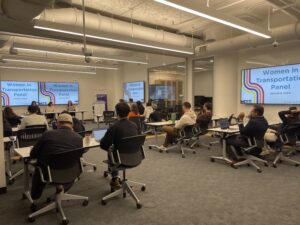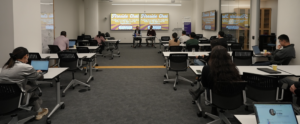LinkedIn LinkedIn LinkedIn Meet 2023-24’s Women in Transportation The Women...
Read MoreOn April 28, 2022, the C2SMART Center in conjunction with ITE convened the 4th Annual Women in Transportation Discussion Panel, bringing together three incredible leaders across multiple dimensions of transpiration and engineering: Susie Lai, Staff Services Traffic Engineer at the Port Authority of New York and New Jersey; Kristy Tu, transportation engineer and planner with the Integrated Planning group at Arup in New York; and Sofia Duran, Traffic Designer at VHB.

The hour-long program, attended by both students and transportation professionals, began with a moderated discussion about lessons learned over the course of panelists’ careers; advice to students just starting out and looking for mentorship; and shared experiences of being a woman in a male-dominated STEM field.
Women make up just over 14% of all transportation workers, despite representing 50% of STEM employees jobs overall [1]. Although many STEM fields have seen progress in terms of gender balance in recent years, engineering has lagged behind, at only 15%. Women in transportation also earn less, earning only 79 cents to every dollar earned by their male colleagues in 2020 – bringing them up short by $8,268 [2].
This is to say nothing of the racial disparities, which are stark: 71% of all engineering employees, regardless of gender, are white [3].
But there are reasons to be optimistic.
“In some ways it’s demoralizing that we are still having these conversations,” said Kristy Tu during the panel, “but in other ways we are seeing meaningful progress.”
This sentiment was echoed by her colleagues. “We’re chipping away,” said Sofia Duran. “That’s why it’s so heartening to see initiatives like the Women in Transportation Seminar which are working to advocate for women in the field.”
Susie Lai pointed to the recent appointment of Bethann Rooney as the Director of the Port Department at the Port Authority of New York and New Jersey, noting that with this appointment, the majority of the Agency’s line department Directors are female. And while we work for a more equitable, diverse workforce, she reminded students in the early stages of their careers that success and recognition must often be fought for.
“I’ll stand on my boss’s desk until he pays attention to me,” she joked. “But you have to put in the work. Make sure that you’re reaching out to the women who are in your workplace who interest and inspire you, and learn as much as you can.”

“And check your own biases,” Tu advised. “None of us are perfect, and it’s an ongoing effort.”
The discussion also covered what it’s like to work in transportation generally, and the emergent theme was, “variety above all.” Whether working for the government, in consulting, or at an engineering firm, all three women discussed how each day can be different, and how being able to learn on the job is a core skill for any woman looking to go into transportation.
“Don’t be afraid to fail,” Lai said. “I don’t like it either – but that’s how you learn.”
Duran agreed. “Try everything! Don’t let yourself get pigeon-holed. You never know what new thing might end up being something you become incredibly passionate about.”
When asked for advice for male colleagues and peers who want to be good allies, there was thoughtful discussion about the many positive ways that each panelist had been supported by male mentors and colleagues — as well as instances of learning. Broadly, the advice was similar: speak up. When a woman is talked over in a meeting, be willing to interrupt and redirect. Recommend overlooked colleagues for projects and responsibilities. If a woman is incorrectly assumed to be the junior colleague, correct the assumption. Listen, and advocate.
There is a long way to go, but the road map is pretty simple.
“Work hard,” said Tu, “and be nice to people.”
Related Posts
6th Annual Women in Transportation Panel
March 11, 2024 To celebrate Women’s History Month, C2SMARTER, the...
Read MoreCUNY City Tech/NYU C2SMARTER Poster Presentation & Social
March 5, 2024 In early March, C2SMARTER’s NYU contingent hosted...
Read MoreStudent Learning Hub: Fireside Chat with Chris Wichman of Airsage
February 21, 2024 On Wednesday, February 21, C2SMARTER hosted a...
Read More



